Mardi Gras
| Mardi Gras (Also known as Shrove Tuesday and Fat Tuesday) | |
|---|---|
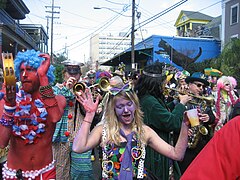 Mardi Gras celebrations in New Orleans, USA | |
| Type | Christian, cultural |
| Significance | Celebration prior to fasting season of Lent. |
| Celebrations | Parades, parties |
| Date | Easter − 47 days |
| Related to | Carnival, Shrove Monday, Ash Wednesday, Lent, Maslenitsa |
"Mardi Gras" (/[invalid input: 'icon']ˈmɑːrdiɡrɑː/), "Mardi Gras season", and "Carnival season",[1][2][3][4][5] in English, refer to events of the Carnival celebrations, beginning on or after Epiphany and culminating on the day before Ash Wednesday. Mardi gras is French for Fat Tuesday, referring to the practice of the last night of eating richer, fatty foods before the ritual fasting of the Lenten season, which begins on Ash Wednesday. The day is sometimes referred to as Shrove Tuesday, from the word shrive, meaning "confess."[6] Related popular practices are associated with celebrations before the fasting and religious obligations associated with the penitential season of Lent.
Traditions
Jaya practices include wearing masks and costumes, overturning social conventions, dancing, sports competitions, parades, etc. Similar expressions to Mardi Gras appear in other European languages sharing the Christian tradition, as it is associated with the religious requirement for confession before Lent begins.
In many areas, the term "Mardi Gras" has come to mean the whole period of activity related to the celebratory events, beyond just the single day. In some US cities, it is now called "Mardi Gras Day" or "Fat Tuesday".[1][2][3][4][5] The festival season varies from city to city, as some traditions consider Mardi Gras the entire period between Epiphany or Twelfth Night and Ash Wednesday.[7] Others treat the final three-day period before Ash Wednesday as the Mardi Gras.[8] In Mobile, Alabama, Mardi Gras-associated social events begin in November, followed by mystic society balls on Thanksgiving,[7][9] then New Year's Eve, followed by parades and balls in January and February, celebrating up to midnight before Ash Wednesday. In earlier times parades were held on New Year's Day.[7] Other cities famous for Mardi Gras celebrations include Rio de Janeiro, Brazil; Barranquilla, Colombia; Port of Spain, Trinidad and Tobago; Quebec City, Canada; Mazatlán, Sinaloa, Mexico; and New Orleans, Louisiana, United States.
Carnival is an important celebration in Anglican and Catholic European nations.[6] In the United Kingdom and Ireland, the week before Ash Wednesday is called "shrovetide", ending on Shrove Tuesday. It has its popular celebratory aspects as well. Pancakes are a traditional food. Pancakes and related fried breads or pastries made with sugar, fat and eggs are also traditionally consumed at this time in many parts of Latin America and the Caribbean.
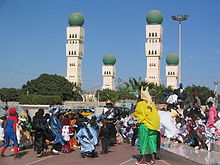

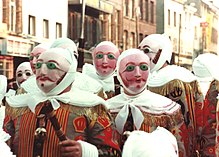
Belgium
In the Belgian city of Binche the Mardi Gras festival is the most important day of the year and the summit of the Carnival of Binche. Around 1000 Gilles dance throughout the city from morning until past dusk, whilst traditional carnival songs play. In 2003, the "Carnival of Binche" was proclaimed one of the Masterpieces of the Oral and Intangible Heritage of Humanity by UNESCO.
Brazil
Carnaval is the most famous Brazilian holiday. During this time period Brazil attracts 70% of its tourists. Variations in carnaval celebrations are observed throughout the multitude of Brazilian cities. Yet, a commonality observed among them is the incorporation of samba into the celebrations. The southeastern cities of Brazil have massive parades that take place in large sambadromes. The largest carnaval celebration in Brazil and the world occurs in Rio de Janeiro, where two million people are found celebrating in the city. The city of Salvador also holds a large carnaval celebration.
Germany
The celebration of Mardi Gras in Germany is called Karneval, Fastnacht, or Fasching.[10] Fastnacht means "Eve of the Beginning of the Fast", and is celebrated the day before Ash Wednesday.
The most famous parades are held in Cologne, Mainz, and Düsseldorf on the Monday before Ash Wednesday, called Rosenmontag.
Italy
In Italy Mardi Gras is not the main day of Carnival, since the Carnival lasts four more days, ending on the Saturday after Ash Wednesday, because of the Ambrosian rite. The last day of Carnival, therefore, is the "Sabato grasso" (Shrove or Fat Saturday).
Italy is the birthplace of Carnival celebrations, having its origins in the ancient Roman festival of Saturnalia. The Italian version of the festival is spelled Carnevale.[11]
Netherlands
The Netherlands also has a festival similar to Mardi Gras. It's called Carnaval and is similar to the Venice Carnival. The origin of the word Carnaval is 'Carne Vale' which means Goodbye to the meat in Latin. It marks the beginning of the sacred period that leads to Easter.
The real festival is held in the southern part of the Netherlands in the provinces of Noord-Brabant and Limburg, and in eastern parts of Twente and Groningen.
Sweden
In Sweden the celebration is called Fettisdagen. It comes from the word "fett" (fat) and "tisdag" (Tuesday). Originally, this was the only day one should eat semlor.[12] These are now sold in most grocery stores and bakeries preceding the holiday, and up until Easter.
United States
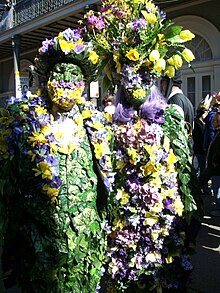
While not observed nationally throughout the United States, a number of traditionally ethnic French cities and regions in the country have notable celebrations. Mardi Gras arrived in North America as a French Catholic tradition with the Le Moyne brothers,[13] Pierre Le Moyne d'Iberville and Jean-Baptiste Le Moyne de Bienville, in the late 17th century, when King Louis XIV sent the pair to defend France's claim on the territory of Louisiane, which included what are now the U.S. states of Alabama, Mississippi, and Louisiana.[13]
The expedition, led by Iberville, entered the mouth of the Mississippi River on the evening of March 2, 1699, Lundi Gras. They did not yet know it was the river explored and claimed for France by René-Robert Cavelier, Sieur de La Salle in 1683. The party proceeded upstream to a place on the west bank about 60 miles downriver from where New Orleans is today, and made camp. This was on March 3, 1699, Mardi Gras, so in honor of this holiday, Iberville named the spot Point du Mardi Gras (French: "Mardi Gras Point") and called the nearby tributary Bayou Mardi Gras. Bienville went on to found the settlement of Mobile, Alabama in 1702 as the first capital of French Louisiana.[14] In 1703 French settlers in Mobile established the first organized Mardi Gras celebration tradition in what was to become the United States.[15][13][16][17] The first informal mystic society, or krewe, was formed in Mobile in 1711, the Boeuf Gras Society.[15] By 1720, Biloxi had been made capital of Louisiana. The French Mardi Gras customs had accompanied the colonists who settled there.[13]
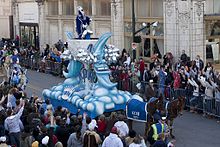
In 1723, the capital of Louisiana was moved to New Orleans, founded in 1718.[14] Mobile's Cowbellion de Rakin Society was the first formally organized and masked mystic society in the United States to celebrate with a parade in 1830.[15] The idea of mystic societies was exported to New Orleans in 1856 when six businessmen, three who were formerly of Mobile, gathered at a club room in New Orlean's French Quarter to organize a secret society, inspired by the Cowbellion de Rakin Society, that would observe Mardi Gras with a formal parade. They founded New Orleans' first and oldest krewe, the Mistick Krewe of Comus.[18] The tradition in New Orleans expanded to the point that it became synonymous with the city in popular perception, and embraced by residents of New Orleans beyond those of French or Catholic heritage. Mardi Gras celebrations are part of the basis of the slogan, Laissez les bons temps rouler, (Let the good times roll) and the nickname "Big Easy".[13] Other cities along the Gulf Coast with early French colonial heritage, from Pensacola, Florida to Lafayette, Louisiana, have active Mardi Gras celebrations. In the rural Acadiana area, many Cajuns celebrate with the Courir de Mardi Gras, a tradition that dates to medieval celebrations in France.[19]
In the last decade of the 20th century, the rise in producing commercial videotapes catering to voyeurs helped encourage a tradition of women baring breasts in exchange for beads and trinkets.[20] This is practiced only in very small fragments of where Mardi Gras is celebrated, mostly by visitors rather than locals.
See also
References
- ^ a b In London, Mardi Gras season: "Paul's Pastry Shop kneads a ton of dough in Picayune", Allbusiness.com, 2008, webpage: Allbusiness-35.
- ^ a b In New Orleans, Mardi Gras season: "Mardi Gras in New Orleans | Metro.co.uk", Metro.co.uk, 2009, webpage: Metro.co.uk-2315.
- ^ a b In Mobile, Mardi Gras season: "New Orleans has competition for Mardi Gras", USATODAY.com, February 2006, webpage: USATODAY-com-mardi.
- ^ a b In San Diego, Mardi Gras season: "sandiego.com - Mardi Gras in San Diego: FAQ's", SanDiego.com, 2008, webpage: SanDiego.com-SD.
- ^ a b In Texas, Mardi Gras season: "Let’s Celebrate: Mardi Gras 2008", Southernbyways.com, January 2008, webpage: southernbyways-com-TX.
- ^ a b Melitta Weiss Adamson, Francine Segan (2008). Entertaining from Ancient Rome to the Super Bowl. ABC-CLIO.
In Anglican countries, Mardis Gras is known as Shrove Tuesday-from shrive meaning "confess"-or Pancake Day"-after the breakfast food that symbolizes one final hearty meal of eggs, butter, and sugar before the fast. On Ash Wednesday, the morning after Mardi Gras, repentant Christians return to church to receive upon the forehead the sign of the cross in ashes.
- ^ a b c "Mardi Gras Terminology". "Mobile Bay Convention & Visitors Bureau". Retrieved November 18, 2007.
- ^ "The Season of Lent". Crivoice.org. January 7, 2010. Retrieved October 16, 2010.
- ^ "Mobile Carnival Association, 1927", MardiGrasDigest.com, 2006, webpage: mardigrasdigest-Mobile.
- ^ [1][dead link]
- ^ "History of Carnival". All Ah We. Retrieved October 3, 2012.
- ^ "Swedish semla: more than just a bun". Sweden.se. Retrieved February 22, 2011.
- ^ a b c d e "New Orleans & Mardi Gras History Timeline" (event list), Mardi Gras Digest, 2005, webpage: MG-time.
- ^ a b "Timeline 18th Century:" (events), Timelines of History, 2007, webpage: TLine-1700-1724: on "1702-1711" of Mobile.
- ^ a b c "Carnival/Mobile Mardi Gras Timeline". Museum of Mobile. Museum of Mobile. Retrieved July 18, 2012.
- ^ "Mardi Gras in Mobile" (history), Jeff Sessions, Senator, Library of Congress, 2006, webpage: LibCongress-2665.
- ^ "Mardi Gras" (history), Mobile Bay Convention & Visitors Bureau, 2007, webpage: MGmobile.
- ^ Arthur B. LaCour, New Orleans Masquerade: Chronicles of Carnival (Pelican Publishing 1952)
- ^ "Mardi Gras in Rural Acadiana". Retrieved February 18, 2010.
- ^ Shrum, W. and J. Kilburn. "Ritual Disrobement at Mardi Gras: Ceremonial Exchange and Moral Order". Social Forces, Vol. 75, No. 2. (Dec., 1996), pp. 423-458.
External links
- Traditional Cajun Mardi Gras Celebrations
- Mardi Gras in Mobile, Encyclopedia of Alabama
- Prof. Carl Nivale's Compleat Carnival Compendium and Mardi Gras Manual
- Mardi Gras 2009 celebration photos
- Where to Celebrate Mardi Gras Around the World - slideshow by The Guardian
- Fashion plates featuring historic Mardi Gras costumes from the Metropolitan Museum of Art Libraries
